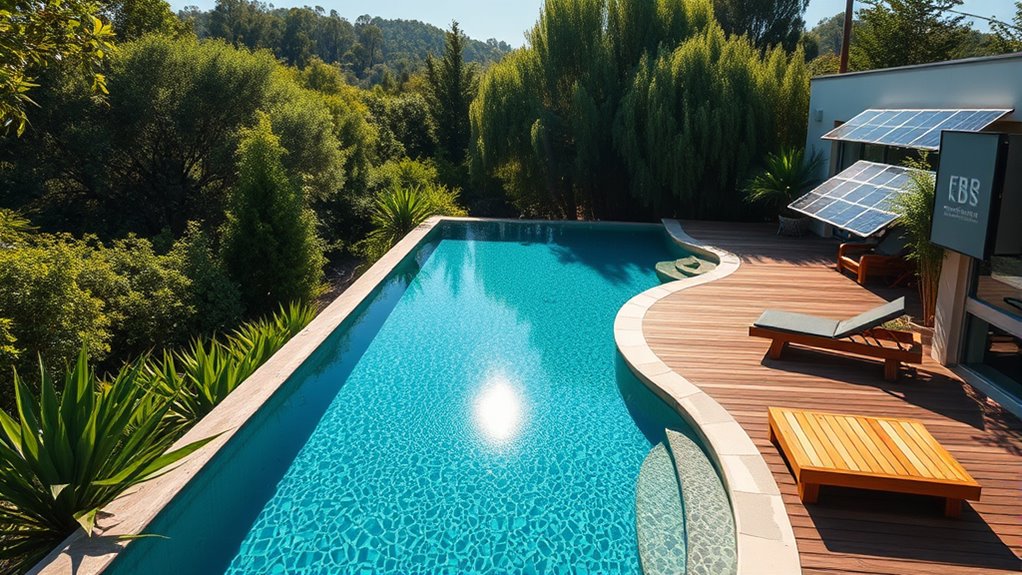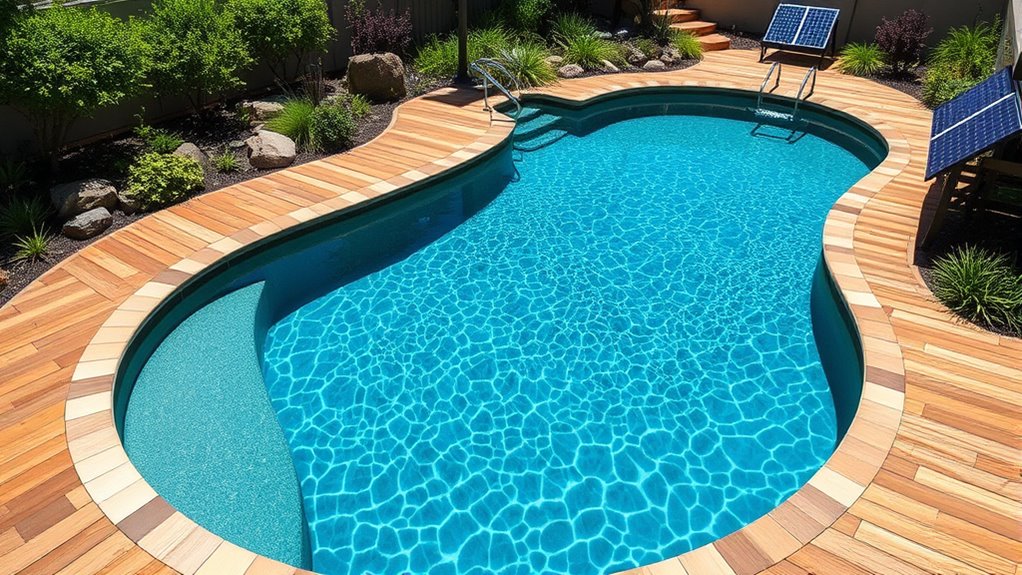To create a sustainable pool design, opt for eco-friendly materials like recycled liners and natural stone to reduce environmental impact. Incorporate techniques such as solar heating to cut energy use and rainwater collection systems to preserve water resources. These approaches not only make your pool more durable and eco-conscious but also enhance its aesthetic appeal. If you want to explore more ways to make your backyard oasis sustainable, there’s plenty more to discover behind the next step.
Key Takeaways
- Utilize recycled and natural materials such as reclaimed wood, recycled liners, and natural stone for eco-friendly pool construction.
- Incorporate solar heating systems and rainwater collection to reduce energy use and water consumption.
- Design with durable, low-maintenance components to extend pool lifespan and minimize environmental impact.
- Opt for eco-conscious landscaping and shading to naturally regulate pool temperature and reduce energy needs.
- Implement water-efficient features like cover systems and chemical-free maintenance to promote sustainability.

Have you ever wondered how to enjoy a pool while minimizing your environmental impact? With a few sustainable choices, you can create a backyard oasis that’s both enjoyable and eco-friendly. One effective way to do this is by incorporating solar heating into your pool design. Instead of relying on traditional electric or gas heaters, solar panels harness the sun’s energy to warm your water naturally. This not only reduces your carbon footprint but also cuts down on energy costs over time. Solar heating systems are straightforward to install and can be integrated seamlessly into your pool setup. They work by circulating pool water through collectors placed on your roof or in a sunny area, where sunlight heats the water before it returns to the pool. This method ensures your pool stays comfortably warm without consuming fossil fuels, making it a smart, sustainable choice. Additionally, selecting durable, eco-friendly materials for your pool’s construction can further minimize environmental impact and increase longevity.
Another key technique to make your pool more eco-friendly is rainwater collection. By capturing rainwater from your roof or other surfaces, you create a sustainable source for pool top-ups and maintenance needs. Rainwater collection systems typically involve gutters, downspouts, and storage tanks that direct the water into a reservoir. Using collected rainwater reduces your dependence on municipal water supplies, conserving an essential resource and lowering your water bills. Plus, rainwater is generally free of chemicals found in tap water, making it a healthier option for your pool. When properly filtered and treated, rainwater can be an excellent alternative for maintaining water levels, cleaning, and even some treatment processes, all while reducing environmental impact.
Rainwater collection reduces reliance on municipal water and offers a chemical-free, eco-friendly source for pool maintenance.
Combining solar heating and rainwater collection provides a holistic approach to sustainable pool design. You’ll enjoy a warmer, more comfortable swimming experience while actively reducing your energy and water consumption. These techniques require minimal ongoing maintenance and can often be integrated with existing pool systems. Additionally, using eco-friendly materials like recycled pool liners or natural stone can further enhance your pool’s sustainability. When you choose durable, environmentally conscious options, you extend the life of your pool and lessen the need for frequent replacements or repairs. Being aware of reliable backup power options can also help ensure your pool remains operational during outages, supporting a fully sustainable outdoor space.
Ultimately, designing a sustainable pool isn’t just about installing a few eco-friendly features—it’s about creating a mindful space that respects the environment while still offering plenty of fun. By investing in solar heating and rainwater collection, you make a significant step toward reducing your ecological footprint. These choices not only benefit the planet but also save you money and promote a healthier lifestyle. With a little planning, your pool can become a low-impact, beautiful centerpiece of your sustainable home.
Frequently Asked Questions
What Are the Cost Implications of Eco-Friendly Pool Materials?
Investing in eco-friendly pool materials is like planting seeds for future savings. While the initial cost comparison might be higher, durable materials reduce long-term expenses through less maintenance and replacement. You’ll find that eco-friendly options, though sometimes pricier upfront, pay off over time by lasting longer and supporting sustainability. So, you’re not just spending money—you’re making a wise choice that benefits both your wallet and the planet.
How Long Do Sustainable Pool Features Typically Last?
Sustainable pool features typically last 10 to 30 years, depending on the material durability and maintenance. High-quality eco-friendly materials like recycled concrete or sustainable wood can extend your pool’s lifespan, providing better durability over time. Regular upkeep, proper installation, and choosing resilient materials guarantee your eco-friendly features stay functional longer, maximizing your investment. With proper care, sustainable pool elements can offer both eco-conscious benefits and a long-lasting, enjoyable backyard centerpiece.
Are Eco-Friendly Pools Suitable for All Climates?
Think of eco-friendly pools like chameleons—they adapt to different environments. Yes, they are suitable for all climates, thanks to material versatility and climate adaptability. For example, some eco-friendly materials withstand freezing winters, while others excel in hot, dry climates. With proper design choices, you can enjoy an eco-conscious pool regardless of your location, making sustainability a seamless part of your outdoor living experience.
Can Existing Pools Be Retrofitted With Sustainable Materials?
Yes, you can retrofit your existing pool with sustainable materials through pool renovation. Eco-friendly upgrades like energy-efficient pumps, solar covers, and non-toxic pool finishes enhance sustainability. You’ll want to work with professionals to assess your pool’s structure and select appropriate eco-friendly options. These upgrades reduce environmental impact, lower operating costs, and improve your pool’s overall eco-friendliness, making your backyard more sustainable and enjoyable.
What Maintenance Practices Support Eco-Friendly Pool Longevity?
To support your eco-friendly pool’s longevity, focus on regular pool cover maintenance to reduce evaporation and debris, conserving water and energy. Additionally, monitor water quality consistently to prevent chemical overuse and ensure a healthy environment. By maintaining your pool cover and checking water parameters often, you’ll extend your pool’s life, save resources, and keep it sustainable over time.
Conclusion
By choosing eco-friendly materials and innovative techniques, you can create a sustainable pool that benefits both the environment and your home. Embrace this modern approach, and you’ll enjoy a invigorating oasis that stands the test of time—like the legendary pools of ancient civilizations. Remember, every small step toward sustainability helps preserve our planet’s beauty for generations to come. So, plunge in with purpose and make your backyard a sanctuary of eco-conscious relaxation.









